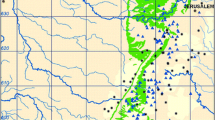Summary
Three precipitation regions in California are identified, mapped and otherwise described. Four independent sources of precipitation variation were discovered by a P-mode principal components analysis of a covariance matrix and they, plus a fifth dimension of station means, were evaluated by Ward's [14] algorithm in order to arrive at the regionalization. A discussion of the present application of this methodology is also included as it is thought to be a more appropriate procedure than those described by Willmott [16] and others. Data for the study were 120 monthly precipitation totals observed from 1961–1970 at each of 90 randomly chosen stations within California.
Zusammenfassung
Drei Niederschlagsregionen in Kalifornien werden identifiziert und näher beschrieben. Vier voneinander unabhängige Quellen der Niederschlagsvariabilität wurden durch eine Hauptkomponentenanalyse der Kovarianzmatrize aufgedeckt und zusammen mit den als fünfte Dimension fungierenden Stationsmittelwerten an Hand von Ward's [14] Algorithmus ausgewertet, um die regionalen Verhältnisse abzuleiten. Eine Diskussion der gegenwärtigen Anwendungsmöglichkeiten dieser Methode ist beigefügt. Diese Methode scheint erfolgreicher zu sein, als die von Willmott [16] und anderen früher beschriebenen. Die Eingangsdaten bestanden aus 120 monatlichen Niederschlagssummen aus den Jahren 1961–1970 von 90 willkürlich gewählten kalifornischen Stationen.
Similar content being viewed by others
References
Burt, C.: Factors of the Mind: An Introduction to Factor-analysis in Psychology. New York: Macmillan Comp. 1941.
Cattell, R. B.: The Scree Test for the Number of Factors. Multivariate Behavioral Res.1, 245–276 (1966).
Craddock, J. M.: Problems and Prospects for Eigenvector Analysis in Meteorology. The Statistician22, 133–145 (1973).
Daultrey, S.: Principal Components Analysis. Norwich, England: Geo Abstracts Ltd., Univ. of East Anglia, 1976.
Dixon, W. J. (ed.): BMD-Biomedical Computer Programs. Los Angeles: Univ. of California Press, 1974.
Dyer, T. G. J.: On the Components of Time Series; The Removal of Spatial Dependence. Quart. J. R. Met. Soc.102, 157–165 (1976).
Dyer, T. G. J.: The Assignment of Rainfall Stations Into Homogeneous Groups: An Application of Principal Component Analysis. Quart. J. R. Met. Soc.101, 1005–1013 (1975).
Gregory, S.: On the Delimitation of Regional Patterns of Recent Climatic Fluctuations. Weather30, 276–287 (1975).
Pyke, C. B.: Some Meteorological Aspects of the Seasonal Distribution of Precipitation in the Western United States. Los Angeles: Univ. of California, Water Res. Center 1972.
Rummel, R. J.: Applied Factor Analysis. Evanston: Northwestern Univ. Press 1970.
Sneath, P. H., Sokal, R. R.: Numerical Taxonomy: The Principles and Practice of Numerical Classification. San Francisco: W. H. Freeman 1973.
Steiner, D.: A Multivariate Statistical Approach to Climatic Regionalization and Classification. Tijdschrift van het Koninklijk Nederlandsch Aardrijkskundig Genootschap82, 329–347 (1965).
U. S. Dept. of Commerce: Climatological Data California, Annual Summaries. Wash., D. C.: G. P. O., 1961–1970.
Ward, J. H.: Hierarchical Grouping to Optimize an Objective Function. Amer. Stat. Assoc. J.58, 236–244 (1963).
Wicks, D., Willmott, C. J.: An Empirical Method for the Spatial Interpolation of Precipitation in California. Paper Presented to the Annual Meeting of the Association of American Geographers (1978).
Willmott, C. J.: A Component Analytic Approach to Precipitation Regionalization in California. Arch. Met. Geoph. Biokl., Ser. B24, 269–281 (1977).
Willmott, C. J.: A Component Analytic Approach to Precipitation Regionalization in California. Paper Presented to the Annual Meeting of the Southern California Academy of Sciences (1974).
Willmott, C. J.: Toward a New Climatic Regionalization of the Contiguous United States. Proceedings of the Second National Solar Radiation Data Workshop. Huntsville, Alabama: Johnson Environmental and Energy Center, Univ. of Alabama, D1-D11, 1977.
Wishart, D.: CLUSTAN 1C: User Manual. London: Univ. College Computer Center 1975.
Author information
Authors and Affiliations
Additional information
With 8 Figures
Rights and permissions
About this article
Cite this article
Willmott, C.J. P-mode principal components analysis, grouping and precipitation regions in California. Arch. Met. Geoph. Biokl. B. 26, 277–295 (1978). https://doi.org/10.1007/BF02243232
Received:
Issue Date:
DOI: https://doi.org/10.1007/BF02243232




